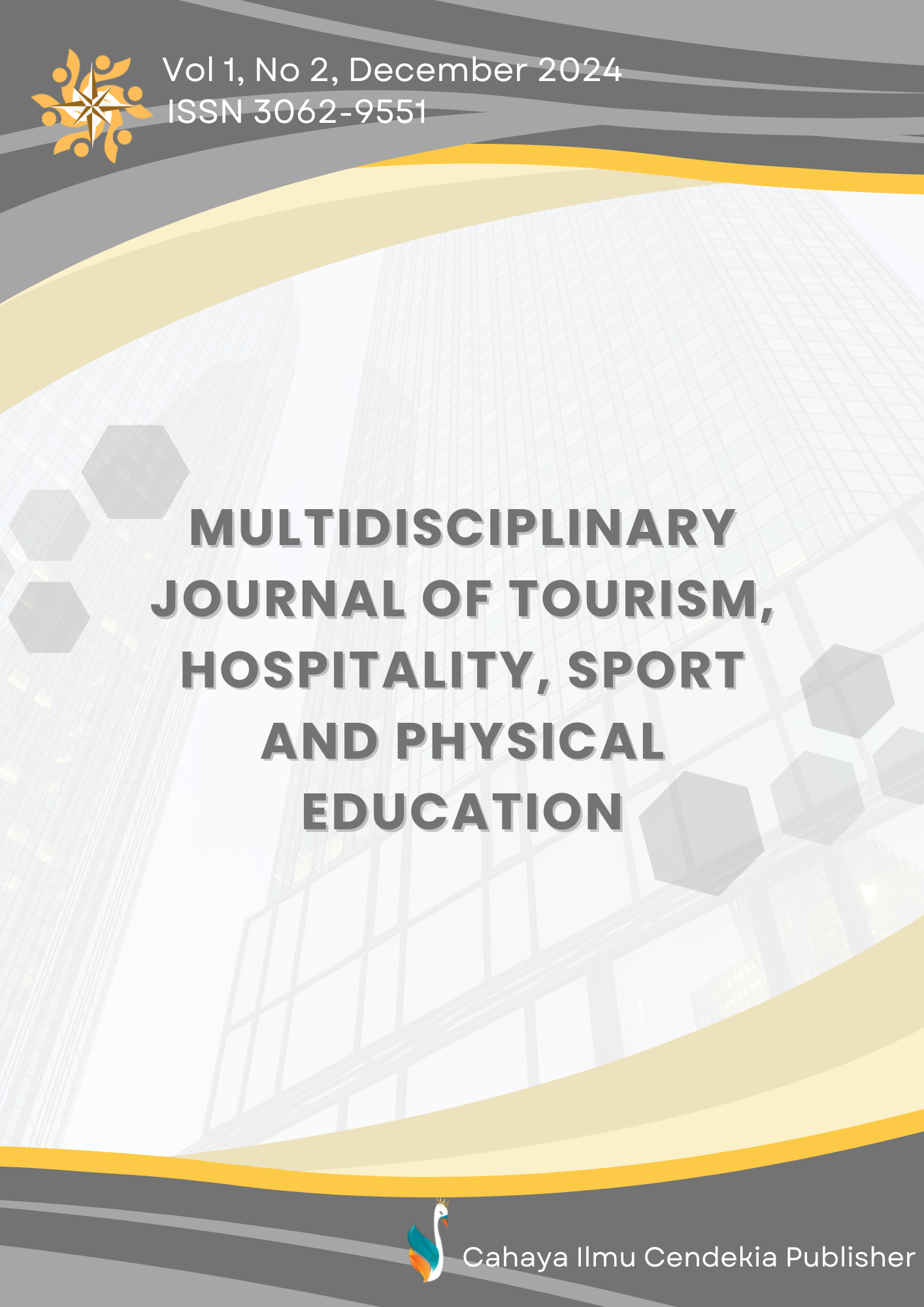Analysis of the Contribution of Bantimurung Bulusaraung Nature Tourism Park to the Original Regional Income (PAD) of Maros Regency
Abstract
Purpose of the study: This study aims to examine the contribution of Bantimurung Nature Tourism Park to the Regional Original Income of Maros Regency, identify PAD sources, and evaluate the application of public sector accounting science in the context of this contribution in society.
Methodology: This study uses a qualitative approach. The focus of this study is how the Bantimurung Tourism Park Contribution to the Original Regional Income of Maros Regency and the factors that encourage and inhibit the potential of Bantimurung natural tourism objects. The data sources used in this study are interviews and documents at the Maros Regency Culture and Tourism Office.
Main Findings: The results of the study show that the Original Regional Income (PAD) of Maros Regency increased from 2016 to 2019, but decreased in 2020 due to the COVID-19 pandemic. The contribution of Bantimurung Nature Tourism Park to PAD was highest in 2016 at 4.49%, but decreased to 1.95% in 2020. This decrease was caused by social restrictions which drastically reduced the number of tourists. The contribution of Bantimurung Park greatly affects Maros.
Novelty/Originality of this study: This study analyzes the impact of the COVID-19 pandemic on the contribution of the Bantimurung Bulu Saraung Tourism Park to the PAD of Maros Regency, including the influence of the PSBB policy on tourist visits and regional income. This study also fills the gap in regional tourism literature, evaluates the role of nature tourism in the economy, and offers crisis mitigation strategies, based on empirical data from 2016-2020.
References
N. Prasetyawati, “Perspektif gender dalam pembangunan nasional Indonesia,” IPTEK J. Proc. Ser., vol. 1, no. 5, p. 53, 2018, doi: 10.12962/j23546026.y2018i5.4421.
A. P. Kirani and F. U. Najicha, “Pentingnya pendidikan kewarganegaraan sebagai pedoman dalam menghadapi era society 5.0 mendatang,” J. Educ. FKIP UNMA, vol. 8, no. 2, pp. 767–773, 2022, doi: 10.31949/educatio.v8i2.2391.
S. Ilham, S. N. Syahrir, and D. Supardi, “Analisis kontribusi, pertumbuhan, efisiensi dan efektivitas retribusi pariwisata terhadap pendapatan asli daerah kabupaten Kolaka,” Fair Value J. Ilm. Akunt. dan Keuang., vol. 5, no. 3, pp. 1451–1461, 2022, doi: 10.32670/fairvalue.v5i3.2555.
A. Jamalong, “Peningkatan prestasi olahraga nasional secara dini melalui pusat pembinaan dan latihan pelajar (PPLP) dan pusat pembinaan dan latihan mahasiswa (PPLM),” J. Pendidik. Olahraga, vol. 3, no. 2, pp. 156–168, 2014, doi: 10.31571/jpo.v3i2.127.
M. Mukhlish, “Konsep hukum administrasi lingkungan dalam mewujudkan pembangunan berkelanjutan,” J. Konstitusi, vol. 7, no. 2, p. 067, 2016, doi: 10.31078/jk724.
Dahliah and A. Arfah, “Kontribusi perkembangan pariwisata terhadap pendapatan asli daerah,” YUME J. Manag., vol. 4, no. 2, pp. 201–209, 2021, doi: 10.37531/yume.vxix.877.
I. D. G. Sugihamretha, “Respon kebijakan: mitigasi dampak wabah covid-19 pada sektor pariwisata,” J. Perenc. Pembang. Indones. J. Dev. Plan., vol. 4, no. 2, pp. 191–206, 2020, doi: 10.36574/jpp.v4i2.113.
R. Huda, “Pengembangan ekonomi lokal melalui sektor pariwisata di desa Serang, kecamatan Karangreja, kabupaten Purbalingga,” Aspir. J. Masal. Sos., vol. 11, no. 2, pp. 157–170, 2020, doi: 10.46807/aspirasi.v11i2.1470.
Lusiana, M. Neldi, and S. Sanjaya, “Analisis investasi sektor pariwisata, jumlah objek wisata, jumlah kunjungan wisatawan, dan retribusi kawasan wisata terhadap pendapatan asli daerah di kota Padang,” J. Ris. Akunt. Dan Keuang., vol. 9, no. 1, pp. 25–34, 2021, doi: 10.17509/jrak.v9i1.28964.Copyright.
K. Buditiawan and Harmono, “Strategi pengembangan destinasi pariwisata kabupaten Jember,” J. Kebijak. Pembang., vol. 15, no. 1, pp. 37–50, 2020, doi: 10.47441/jkp.v15i1.50.
N. Nandi, “Pariwisata dan pengembangan sumberdaya manusia,” J. Geogr. Gea, vol. 8, no. 1, pp. 33–42, 2016, doi: 10.17509/gea.v8i1.1689.
J. Morawska-Jancelewicz, “The role of universities in social innovation within quadruple/quintuple helix model: practical implications from polish experience,” J. Knowl. Econ., vol. 13, no. 3, pp. 2230–2271, 2022, doi: 10.1007/s13132-021-00804-y.
A. Abdurrahman, H. Sutanto, Z. Alpian Muhtarom, M. Mujahid Dakwah, and B. Handayani Rinuastuti, “Studi kelayakan hutan lindung monggal sebagai taman wisata alam (TWA) guna meningkatkan daya tarik wisatawan,” Distrib. - J. Manag. Bus., vol. 11, no. 2, pp. 207–218, 2023, doi: 10.29303/distribusi.v11i2.407.
T. Ahmad et al., “Artificial intelligence in sustainable energy industry: Status Quo, challenges and opportunities,” J. Clean. Prod., vol. 289, 2021, doi: 10.1016/j.jclepro.2021.125834.
S. M. &Amandeep D. Dogan Gursoy, “The metaverse in the hospitality and tourism industry: An overview of current trends and future research directions,” J. Hosp. Mark. Manag., vol. 31, no. 5, pp. 527–534, 2022, doi: 10.1080/19368623.2022.2072504.
Y. W. Rosalina, Putu Devi, Karine Dupre, “Rural tourism: A systematic literature review on definitions and challenges,” J. Hosp. Tour. Manag., vol. 47, pp. 134–149, 2021, doi: 10.1016/j.jhtm.2021.03.001.
D.-C. D. Rebeka-Anna Pop, Zsuzsa Săplăcan, “The impact of social media influencers on travel decisions: the role of trust in consumer decision journey,” Curr. Issues Tour., vol. 25, no. 5, pp. 823–843, 2022, doi: 10.1080/13683500.2021.1895729.
. Kerry Turner A, Gaetano Grilli, Emmanouil Tyllianakis b, Tiziana Luisetti, Silvia Ferrini a, “Prospective tourist preferences for sustainable tourism development in Small Island Developing States,” Tour. Manag., vol. 82, pp. 104–178, 2021, doi: 10.1016/j.tourman.2020.104178.
I. P. B. Carunia Mulya Firdausy, “Building back better tourism sector post-COVID-19 pandemic in Indonesia: input-output and simulation analysis,” J. Policy Res. Tour. Leis. Events, vol. 34, no. 2, pp. 125–146, 2022, doi: 10.1080/19407963.2022.2143511.
I. Agustina, M. N. Bin Ajis, and H. A. Pradesa, “Entrepreneur’s perceived risk and risk-taking behavior in the small-sized creative businesses of tourism sector during COVID-19 pandemic,” JEMA J. Ilm. Bid. Akunt. dan Manaj., vol. 18, no. 2, p. 187, 2021, doi: 10.31106/jema.v18i2.12563.
F. De Canio, E. Martinelli, and G. Viglia, “Reopening after the pandemic: leveraging the destination image to offset the negative effects of perceived risk,” Ital. J. Mark., pp. 99–118, 2023, doi: 10.1007/s43039-023-00066-3.
D. Sumantri and T. Rahmat, “Increasing tourist intention to visit of coastal and marine tourism visits through digital marketing,” J. Manajerial, vol. 10, no. 01, p. 81, 2023, doi: 10.30587/jurnalmanajerial.v10i01.4651.
H. Erwin, “Value-based communication strategies and tourism growth : effectiveness-vam model,” J. Ekon., vol. 13, no. 03, pp. 1584–1599, 2024, doi: 10.54209/ekonomi.v13i03.
H. Taherdoost, “What are different research approaches? comprehensive review of qualitative, quantitative, and mixed method research, their applications, types, and limitations,” J. Manag. Sci. Eng. Res., vol. 5, no. 1, pp. 53–63, 2022, doi: 10.30564/jmser.v5i1.4538.
Y. Indahri and S. E. P. Djahimo, “Teaching and researching: identifying problems and finding solutions through classroom action research (CAR),” Aspir. J. Masal. Sos., vol. 9, no. 1, pp. 145–151, 2018, doi: 10.46807/aspirasi.v9i1.993.
M. Waruwu, “Pendekatan penelitian pendidikan: metode penelitian kualitatif, metode penelitian kuantitatif dan metode penelitian kombinasi (Mixed Method),” J. Pendidik. Tambusai, vol. 7, no. 1, pp. 2896–2910, 2023, doi: 10.31004/jptam.v7i1.6187.
W. Isnaeni and K. Kumaidi, “Evaluasi implementasi pkp dalam pembelajaran biologi di SMAN kota Semarang menggunakan pendekatan mixed-method,” J. Penelit. dan Eval. Pendidik., vol. 19, no. 1, pp. 109–121, 2015, doi: 10.21831/pep.v19i1.4561.
S. Sunarti and D. A. Sari, “Religious moderation as the initial effort to form tolerance attitude of elementary school,” AULADUNA J. Pendidik. Dasar Islam, vol. 8, no. 2, p. 138, 2021, doi: 10.24252/auladuna.v8i2a2.2021.
A. Anshori, “Komunikasi organisasi antar budaya di lembaga penjaminan mutu pendidikan Sumatera Utara,” J. Interak. J. Ilmu Komun., vol. 5, no. 1, pp. 11–19, 2021, doi: 10.30596/interaksi.v5i1.5301.
A. Nurdin, S. A. A. Samad, M. Samad, and F. Fakrurrazi, “Government policy regarding education in indonesia: analysis of competence-based curriculum, educational unit level curriculum, and curriculum 2013,” J. Gov. Soc. Policy, vol. 4, no. 1, pp. 139–155, 2023, doi: 10.24815/gaspol.v4i1.31812.
H. R. Ganesha and P. S. Aithal, “How to choose an appropriate research data collection method and method choice among various research data collection methods and method choices during ph.d. program in India?,” Int. J. Manag. Technol. Soc. Sci., vol. 7, no. 2, pp. 455–489, 2022, doi: 10.47992/ijmts.2581.6012.0233.
K. Mwita, “Strengths and weaknesses of qualitative research in social science studies,” SSRN Electron. J., vol. 11, no. 6, pp. 618–625, 2024, doi: 10.2139/ssrn.4880484.
N. Purwaningsih and S. N. Sunaningsih, “Aalisis kontribusi retribusi pariwisata terhadap pendapatan asli daerah sebelum dan sesudah pandemi Covid-19,” J. Ilm. Akunt. Kesatuan, vol. 9, no. 3, pp. 471–478, 2021, doi: 10.37641/jiakes.v9i3.892.
J. RUDYANTO, Rudy PRAMONO, “Perception of Knowledge of the risk of the COVID -19 pandemic regarding touring intentions and tourism travel recommendations,” J. Environ. Manag. Tour., vol. 4, no. 12, 2021, doi: 10.14505//jemt.v12.4(52).08.
E. Iskandar, Z. Taib, and M. R. Septriawan, “Developing a design model for seven charm (Sapta Pesona ) tourism awareness in the local community of Lake Toba,” Tradit. Mod. Humanit., vol. 2, no. 1, pp. 56–72, 2022, doi: 10.32734/tmh.v2i1.8538.
H. Zhang, “Analysis of the overall development mode of cultural tourism under the creative economy environment,” J. Environ. Public Health, vol. 2022, 2022, doi: 10.1155/2022/3498622.
H. T. T. LE, B. T. TONG, N. T. M. VU, L. S. HO, T. V. PHAM, and H. T. T. TRINH, “Landscape function and tourism industry: a case study of moc chau plateau, vietnam,” J. Asian Financ. Econ. Bus., vol. 7, no. 12, pp. 1195–1204, 2020, doi: 10.13106/JAFEB.2020.VOL7.NO12.1195.
C. C. Tsartas, A. R. Chen, C. C. Tsartas, A. R. Chen, and A. F. Devi, “Impact of customs and artifacts on tourism development in south of italy,” J. Hosp. Tour. Manag., vol. 6, no. 5, pp. 1–11, 2023, doi: 10.53819/81018102t5238.
Copyright (c) 2024 Rinaldi Rinaldi, Poramet Hema

This work is licensed under a Creative Commons Attribution 4.0 International License.
Authors who publish with this journal agree to the following terms:
- Authors retain copyright and acknowledge that the Journal of Health Innovation and Environmental Education is the first publisher licensed under a Creative Commons Attribution 4.0 International License.
- Authors are able to enter into separate, additional contractual arrangements for the non-exclusive distribution of the journal's published version of the work (e.g., post it to an institutional repository or publish it in a book), with an acknowledgment of its initial publication in this journal.
- Authors are permitted and encouraged to post their work online (e.g., in institutional repositories or on their website) prior to and during the submission process, as it can lead to productive exchanges and earlier and greater citation of published work.


.png)
.png)
.png)



